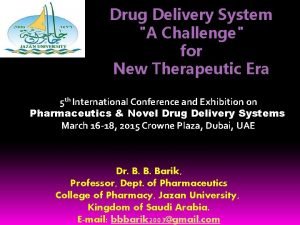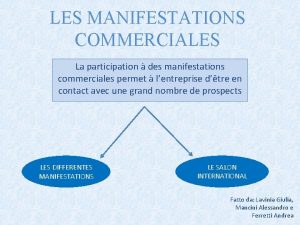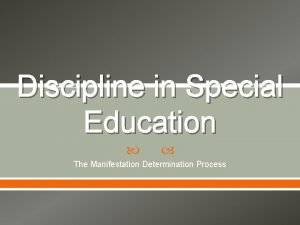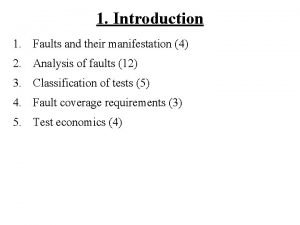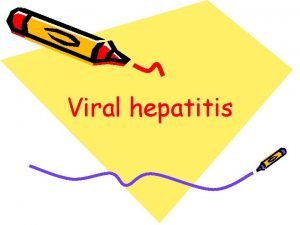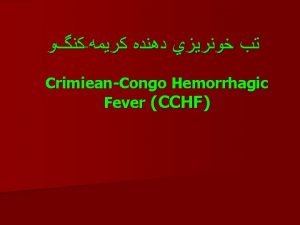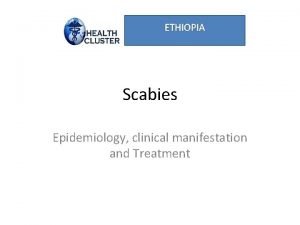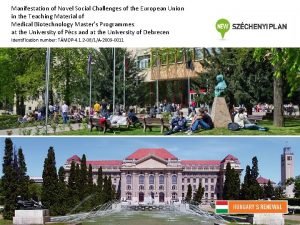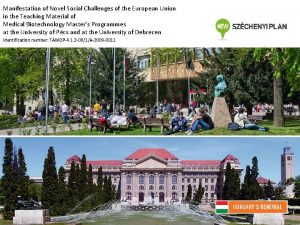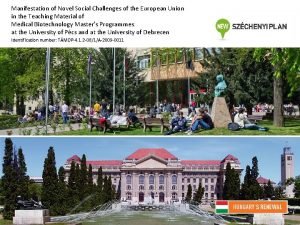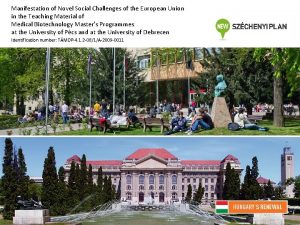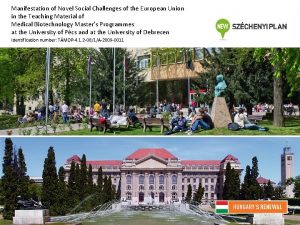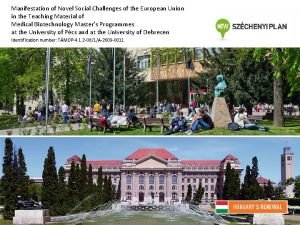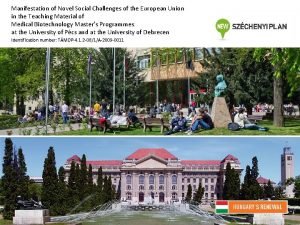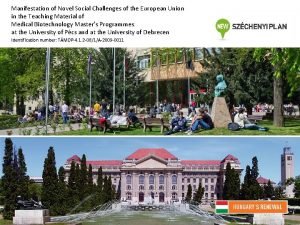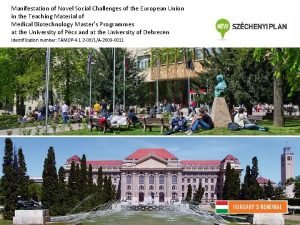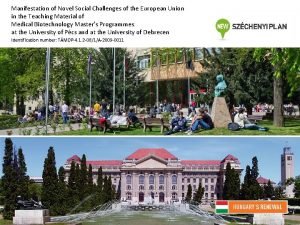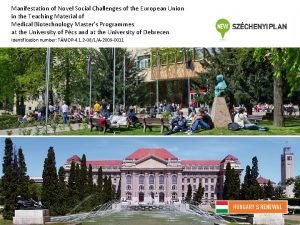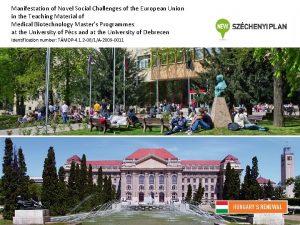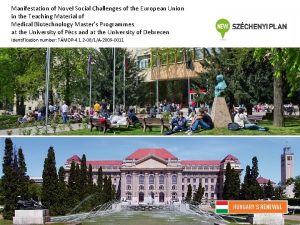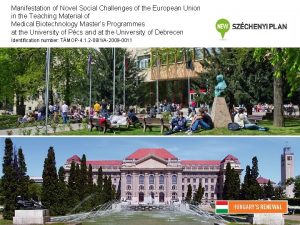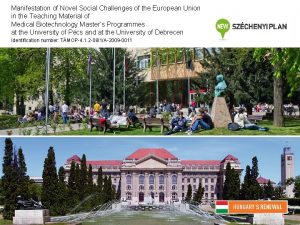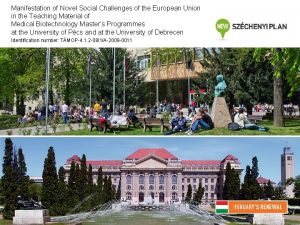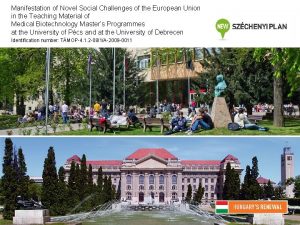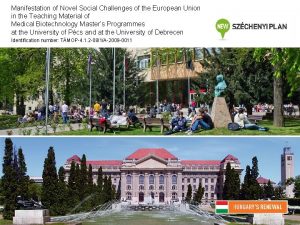Manifestation of Novel Social Challenges of the European




















- Slides: 20

Manifestation of Novel Social Challenges of the European Union in the Teaching Material of Medical Biotechnology Master’s Programmes at the University of Pécs and at the University of Debrecen Identification number: TÁMOP-4. 1. 2 -08/1/A-2009 -0011

Manifestation of Novel Social Challenges of the European Union in the Teaching Material of Medical Biotechnology Master’s Programmes at the University of Pécs and at the University of Debrecen Identification number: TÁMOP-4. 1. 2 -08/1/A-2009 -0011 István Szatmári Molecular Therapies- Lecture 11 EMBRYONIC AND ADULT STEM CELLS IN REGENERATIVE MEDICINE II.

TÁMOP-4. 1. 2 -08/1/A-2009 -0011 The aim of this lecture to discuss the potential application of the embryonic and adult stem cells for cell therapy. This lecture provides general information on stem cell based regenerative medicine. Table of contents 11. 1. Pluripotent stem cells for regenerative medicine Potential applications of stem cells in regenerative medicine Human stem cell sources Example for an i. PS cell based gene correction Pharmacological application of ES cells 11. 2. Clinical application of stem cells Clinical application of adult stem cells Curative potential of hematopoietic stem cells (HSC) Cord blood cell banks: biological life insurance? Possible beneficial mechanisms of autologous stem cells transplantation 11. 3 Stem cell therapy to cure various diseases stem cell therapy to treat heart disease stem cell therapy to treat neurogenerative disease stem cell therapy to treat diabetes

TÁMOP-4. 1. 2 -08/1/A-2009 -0011 Potential applications of stem cells in regenerative medicine: It is hoped that stem cells will play an important role in the treatment of a number of incurable diseases (Alzheimer’s disease, spinal cord injuries, heart failure or diabetes) via transplantation therapy. Stem cells can replace dysfunctional and degenerated cells and the replacement of these cells could offer a lifelong treatment for these disorders. Stem cells can be used to make in vitro a complete organ for autologous transplantation (kidney, heart, pancreas or liver).

TÁMOP-4. 1. 2 -08/1/A-2009 -0011 Human stem cell sources: Donation of excess oocytes (blastocysts) for research purposes from IVF clinics. Intentional in vitro production of early embryos (blastocysts) for ES cell generation. Generation of stem cells by somatic cell nuclear transfer (SCNT). Somatic cells reprogramming into i. PS cells. Cell harvesting from aborted embryos (fetal stem cells). Umbilical cord blood cells (mainly hematopoietic stem cells). Adult stem cell isolation from tissues, organs obtained from surgical procedures (bone marrow, adipose tissue).

TÁMOP-4. 1. 2 -08/1/A-2009 -0011 ES cells for regenerative medicine advantages: Pluripotent cells: They have the potential to generate virtually any somatic cell types. Immortality: they can proliferate indefinitely, thus these cells can profoundly expanded before differentiation and transplantation. They are suitable for genetic modification including gene correction and selection of the modified cells. It is relatively easy to establish them from blastocysts. disadvantages: It is difficult to control their differentiation potential, it is poorly defined their differentiation conditions. The major concern of ES cell therapy is the possible risk that the transplanted cells could form tumors (teratomas) in vivo. There are ethical concerns about utilization of ES cells because early embryos are disrupted upon ES cell generation. However there is no ethical concern if one uses i. PS cells.

TÁMOP-4. 1. 2 -08/1/A-2009 -0011

TÁMOP-4. 1. 2 -08/1/A-2009 -0011 i. PS cells based gene correction reprogramming Patent derived somatic cells Gene correction ES or i. PS cells differentiation Corrected i. PS cells example: Correction the defect of Falcony anemia using i. PS derived blood cell progenitor. Progenitor cell generation and transplantation

TÁMOP-4. 1. 2 -08/1/A-2009 -0011

TÁMOP-4. 1. 2 -08/1/A-2009 -0011 ES/i. PS based cell therapy: Near future? Genetically modified ES derived blood cell progenitors confers a definitive hematopoietic engraftment potential (HSC with longterm repopulating activity) in a mouse model. Mouse skeletal muscle was regenerated with administration of ES derived muscle progenitors: intramuscular or systemic transplantation of these cells into dystrophic mice results in engraftment of adult skeletal muscle with enhanced contractile function. Human ES based cell therapy is still in the research phase, one concern of this therapy is the possible risk that the transplanted ES derived cells could form tumors (teratomas). Important note: Recently, a pediatrics patient has been identified who was treated by repeated transplantations of fetal neural stem cells and who developed a donor cell derived multifocal brain tumor.

TÁMOP-4. 1. 2 -08/1/A-2009 -0011 Pharmacological application of ES cells The therapeutic potential of stem cells has been widely considered, but stem cells also represent an important system suitable to the identification of new molecular targets and the development of novel medicines. Human ES/i. PS cell lines are important tools to the development of safer and more effective drugs for human diseases. ES-derived systems are of special importance for the investigation of embryotoxic properties of teratogenic agents. ES-derived progenitors could be also used as delivery vehicles for the regulated release of drugs or therapeutic proteins.

TÁMOP-4. 1. 2 -08/1/A-2009 -0011 Clinical application of adult stem cells advantages: Adult stem cells normally develop into a narrow set of cell types (multipotency), directing them to a desired fate is easier. Autologous adult stem cells would not be rejected by the immune system. Some adult stem cells are relatively easy to harvest and purify. disadvantages: Adult stem cells are rare in mature tissues and it is difficult to expand them. They have a limited survivor capacity upon cell culture or freezing. These cells are less plastic, only specific cell lines can be obtained from them. They might harbor somatic mutations.

TÁMOP-4. 1. 2 -08/1/A-2009 -0011 Clinical application of hematopoietic stem cells (HSC) Many blood cells are short-lived and need to be regenerated, the continued production of blood cells depends on the presence of HSCs, the ultimate and only source of all blood cells. HSCs have been used clinically since 1959 and are used increasingly routinely for transplantations. Recently more than 40, 000 transplants are performed annually world-wide. HSC transplantation is carried out in the case of hematopoietic cancers (leukemias and lymphomas); other indications include diseases that involve genetic or acquired bone marrow failure. HSC transplantation can be performed in two different settings, autologous and allogeneic. Autologous transplantations employ a patient’s own cells/tissues and thus present no tissue incompatibility between the donor and the host. Allogeneic transplantations occur between two individuals who are not genetically identical; allogeneic grafts must match most of the major HLA antigens between host and donor.

TÁMOP-4. 1. 2 -08/1/A-2009 -0011

TÁMOP-4. 1. 2 -08/1/A-2009 -0011 Cord blood cell banks: biological life insurance? Human umbilical cord blood cells (placental blood cells) can be frozen and stored for a long period of time. They are a readily available stem cell source for regenerative medicine, however it is debated whether cord blood cells storage is necessary and useful for autologous cell therapy. Cord blood contains various stem cell populations: Besides the well characterized CD 34+ hematopoietic stem cells (HSC), mesenchymal stromal cells and unrestricted somatic stem cells can be found in freshly obtained cord blood. Cord blood cells are routinely used for allogeneic transplantation to treat various blood cell disorders (e. g. , leukemia). However, it is arguable whether cryopreserved cord blood cells are useful for autologous stem cell therapy since non HSC stem cells are poorly recovered after unfreezing.

TÁMOP-4. 1. 2 -08/1/A-2009 -0011

TÁMOP-4. 1. 2 -08/1/A-2009 -0011 Possible beneficial mechanisms of autologous transplanted stem cells. 1. Trans-differentiation: The engrafted stem cells might be converted to other cell types in vivo (e. g. HSC transforms into muscle). However, donor derived stem cells undergo functional trans-differentiation has been questioned over the years. Recent findings suggested that probably cell fusion is responsible for the in vivo detected lineage changes. 2. Paracrine effects: Numerous murine and human studies demonstrated that stem cells transplantation into infarcted heart has improvement in cardiac function. The mechanism is still controversial but several observations suggests that these cells act as a ‘feeder’ and produce paracrine factors (cytokines, chemokines) which help on tissue regeneration, cell survivor moreover these factors enhance angiogenesis (blood vessel formation). In summary, autologous stem cell transplantation is not ‘the fountain of eternal youth’ but stem cell based therapy has a reproducible, beneficial effect in various disease models.

TÁMOP-4. 1. 2 -08/1/A-2009 -0011 Application of stem cell therapy to treat heart disease The heart is one of the least regenerative organs in the human body, after birth human heart regeneration becomes limited to very slow cardiomyocyte replacement. The human left ventricle containes 2– 4 billion cardiomyocytes, and a myocardial infarction can kill 25% of these cells in a few hours. A resident population of cardiac progenitor cells (CPCs) were identified in heart, these cells are c-KIT positive. A clinical trial is under way, testing autologous c-KIT+ cells as an adjunctive treatment for patients undergoing coronary bypass surgery. The ‘stemness’ of CPCs has recently been questioned, and it found that these cells are principally cardiac fibroblasts and not real progenitors of cardiomyocytes. Clinical trials have also focused on the delivery of bone marrow mononuclear cells by the coronary circulation. These trials indicate that the delivery of bone marrow cells through the coronaries is feasible and safe, but the benefits are modest.

TÁMOP-4. 1. 2 -08/1/A-2009 -0011 Application of stem cell therapy to treat neurogenerative disease Alzheimer disease (AD) and Huntington disease (HD) develops over a long period of time and result in widespread loss of neurons in the brain, whereas Parkinson disease (PD) involves the specific loss of dopamine producing cells in the substantia nigra. Neurodegenerative diseases create an enormous burden on society due to their devastating nature, cost and lack of effective therapies. The NIH has sponsored two large clinical trials in which cells from aborted fetuses were transplanted into the striatum of patients with Parkinson’s disease. The patients’ progress was followed for up to eight years. Both studies showed that the transplants offered little benefit to the patients as a group, however some patients showed improvement. The ability to produce i. PS derived, patient specific dopamine producing cells has recently been demonstrated. Transplantation of these cells into a rodent PD model improved functional deficits and demonstrated cell integration in the host tissue.

TÁMOP-4. 1. 2 -08/1/A-2009 -0011 Application of stem cell therapy to treat diabetes Diabetes can be defined as a deficiency of insulin-producing beta-cell mass. Transplantation-based therapeutic approaches aimed at restoring the insulin producing capacity of the impaired beta cells. Islet grafts have demonstrated that patients with diabetes would benefit greatly by beta-cell therapy. However, the paucity of available islets for transplantation as well as the immunological reactions faced in allogenetic transplantation represents a tremendous barrier to this approach. A type of trans-differentiation currently being studied by several labs is the conversion of liver cells to pancreatic beta cells. This is because reprogramming of hepatocytes could act as an innovatory method of generating transplantable insulin producing beta-cells. An alternative approach involves the combination of in vitro ES/i. PS cell-derived pancreatic progenitor generation, followed by in vivo differentiation, and maturation into glucose- responsive beta-cells. It was described that committed pancreatic progenitors, when injected into mice tissue can give rise to glucose responsive, insulin-secreting cells.
 Challenges of novel drug delivery system
Challenges of novel drug delivery system Manifestation physique
Manifestation physique Manifestation commerciale exemple
Manifestation commerciale exemple Manifestation meeting for 504
Manifestation meeting for 504 Manifestation determination flowchart
Manifestation determination flowchart Manifestation determination flowchart
Manifestation determination flowchart Rayon rubis doré
Rayon rubis doré The manifestation of the holy spirit
The manifestation of the holy spirit Besoins fondamentaux de virginia henderson
Besoins fondamentaux de virginia henderson Manifestation determination process
Manifestation determination process A failure is a manifestation of an
A failure is a manifestation of an Manifestation names
Manifestation names Neonatal jaundice
Neonatal jaundice Manifestation names
Manifestation names Cchf
Cchf Vocabulaire manifestation
Vocabulaire manifestation How sunnatullah manifested in the universe and human life
How sunnatullah manifested in the universe and human life Friday manifestation
Friday manifestation Scabies clinical manifestation
Scabies clinical manifestation Social thinking adalah
Social thinking adalah Social thinking social influence social relations
Social thinking social influence social relations
